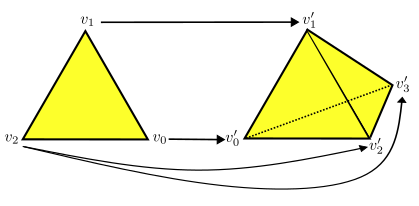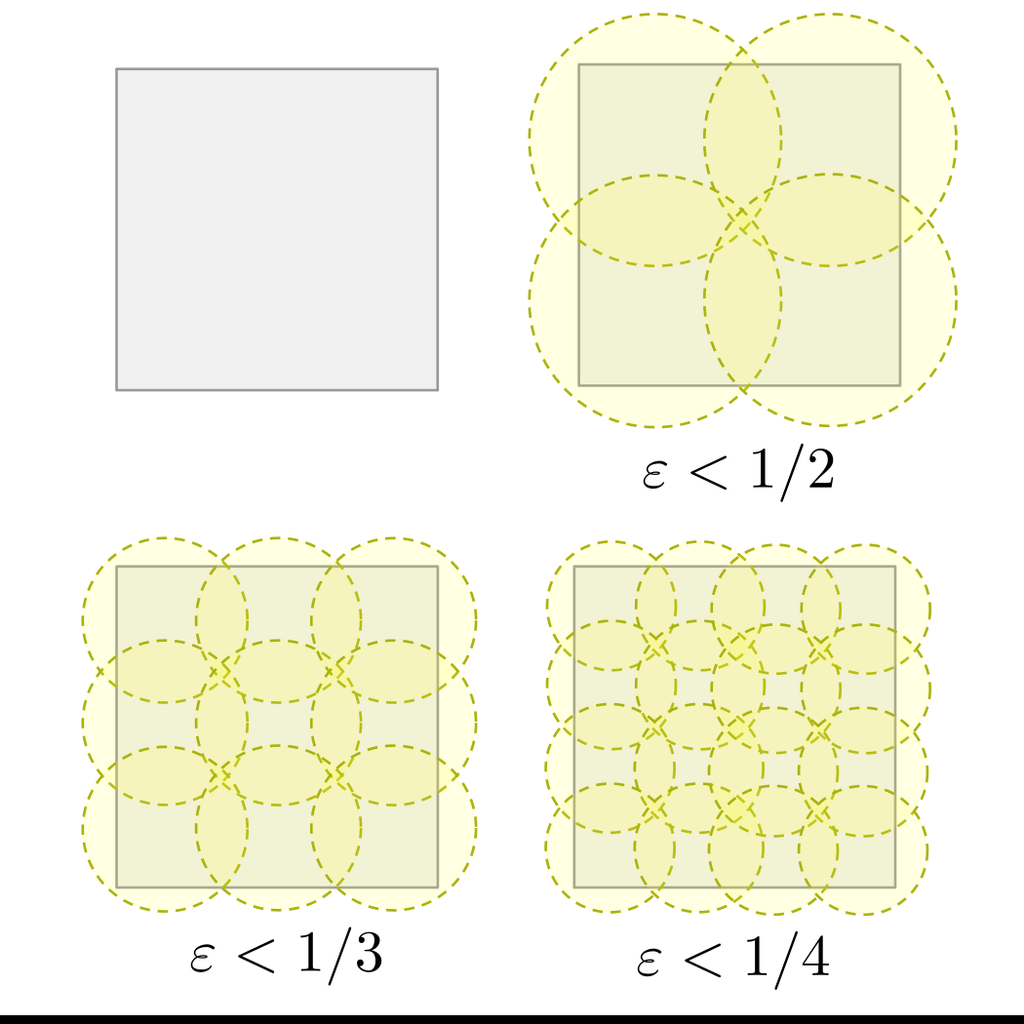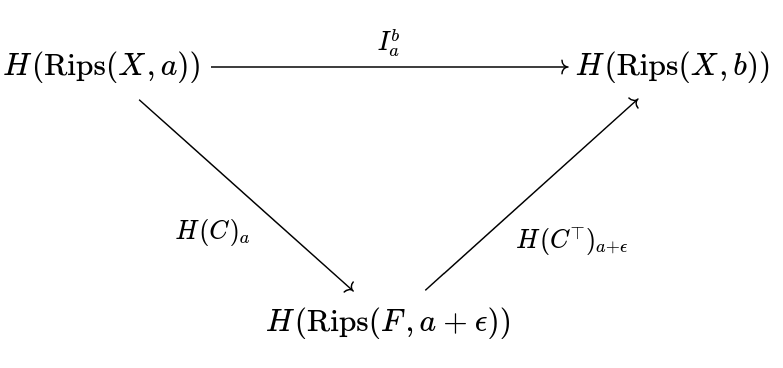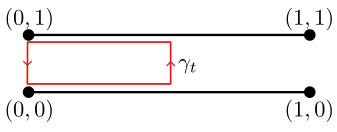The following is a brief summary of Persistence stability for geometric complexes.
Introduction
Given a data set on a metric space that approximates a metric space , we want to construct a simplicial complex on such that and have the same homology or homotopy type. In most applications, is finite.
One common approach is to use Vietoris-Rips complex:
For a closed Riemannian manifold , the geometric realization of the Vietoris-Rips complex that approximates is homotopy equivalent for sufficiently small . That is, if the Gromov-Hausdorff distance between and is sufficiently small, then there is some such that is homotopy equivalent to .
Finding the correct radius can be difficult in practice. To simplify things we often take the persistence module
It was shown by Chazal et. al. that if and are finite metric spaces, then
where is the bottleneck distance and is the Gromov-Hausdorff distance. This result is beneficial as the bottleneck distance is computationally simpler than the Gromov-Hausdorff distance. Thus, we seek upper bounds on the bottleneck distance.
Thm
If is a -tame persistence module then it has a well-defined persistence diagram . If and are -tame persistence modules that are -interleaved then
See 2024-08-30 for more details.
Gromov-Hausdorff Distance
Let be a closed subset of a metric space . For we define the -thickening of to be given by
where is the ball centered at with radius . We define the Hausdorff distance by
One may view the Hausdroff distance as the farthest distance from any point of from , or the farthest distance any point of from (take the larger of the two). This distance forms a metric on the set of closed sets in .
The Gromov-Hausdorff distance makes use of the Hausdorff distance to measure the distance between two metric spaces. That is, given two closed metric spaces and both inside a larger metric space , the Gromov-Hausdorff distance is given by
where denotes an isometric embedding of into . We take the infimum over all possible embeddings. The Gromov-Hausdorff distance gives us a measure on how close two metric spaces are from being isometric. As a result, the set of all isometry classes of a metric space is itself a metric space.
One may show that the Gromov-Hausdorff distance is equivalent to the Gromov-Hausdorff approximation which is given by
ε-simplicial Multi-valued Maps
We extend the notion of maps to allow for multiple outputs. That is, we define a multi-valued map to be a subset of such that for all , there is some such that , i.e., the projection is surjective.
Given two multi-valued maps and , we can compose the two to get a new multi-valued map where if and only if there is some such that and .
We say that a single-valued map is subordinate to a multi-valued map , denoted . if for all .
Let and be filtered simplicial complexes with vertex sets and . We say that a multi-valued map is -simplicial if for any and any simplex it follows that every finite subset of the image is a simplex of .
Example: Consider the filtered simplicial complex where each complex is the standard -simplex. Consider then the multi-valued map given below:

Notice that every simplex in , the subsets of are simplices in . Therefore, this multi-valued map is 1-simplicial.
-simplicial maps induce a homomorphism of degree between persistence diagram.
Prp
Given two filtered simplicial complexes with vertex sets and a -simplicial map then induces the map that is given by for any .
Here is the persistence module we get by applying the simplicial homology functor to .
Correspondences
Given a multi-valued map , we say that is a correspondence if every has at least one such that , i.e., the projection is surjective. Alternatively, one may view a correspondence as a multi-valued map where the transpose given by
is also a multi-valued map.
Correspondences can be seen as a form of “weak bijection”. Notice that if is a correspondence, then
Moreover if both and are -simplicial maps, then we get two homomorphisms of degree . It turns out these two homomorphisms induce an -interleaving.
Prp
Let be filtered simplicial complexes with vertex sets and . If is a correspondence such that and are both -simplicial, then and induce an -interleaving between and .
This result applied to -tame persistence modules provides a framework for finding an upper bound on the bottleneck distance, i.e., if two filtered simplicial complexes with -tame persistence modules have a correspondence between their vertex sets such that and are -simplicial, then
For example, we claim that given metric spaces and if then the persistence modules and are -interleaved. To prove this, we first introduce the notion of distortion: given a multi-valued map between metric spaces, the distortion of is given by
One may show that the Gromov-Hausdorff distance is given by the smallest possible distortion between the two spaces:
We may now prove the result.
Lemma
Let and be metric spaces. If then the persistence modules and are -interleaved.
Proof: Since there is a correspondence with . Take and a finite subset . Since , for any there is some such that , and
If we use the reverse triangle inequality then we get that
Therefore, . Thus, is -simplicial. A similar argument shows that is also -simplicial. Therefore, the persistence modules and are -interleaved.
Q.E.D.
A similar argument shows this result holds for Cech complexes as well, i.e., the simplicial complex defined by
where is the closed ball with center and radius .
Lemma
Let and be metric spaces. If then the persistence modules and are -interleaved.
Stability of Rips and Cech Complexes
We have seen that for sufficiently large two Rips (or two Cech) persistence modules are -interleaved. We now seek a condition in which they are -tame as well. In such a scenario, we are given an upper bound on their bottleneck distances.
Given a subset of a metric space , we say that is an -sample of if for every , there is some such that . The metric space is totally bounded if it has a finite -sample for every .

One may alternatively view -samples as subsets that approximate the metric space . Thus, a space is totally bounded if we can approximate with finitely many points for any level of accuracy .
Lemma
If is totally bounded, then the persistence modules and are -tame.
Proof: Let be an -sample and construct the correspondence
i.e., the correspondence that maps every to its set of approximate values in . Notice that
Thus, which implies that there is an -interleaving between and . Notice that for the map factors into

Since is finite dimensional, is finite-dimensional. Therefore, has finite rank, i.e., the persistence module is -tame. The proof for the Cech complex is the same.
Q.E.D.
As a consequence, we get an upper bound on the bottleneck distances.
Thm
Let and be totally bounded metric spaces. Then
and
Note that there exists simplicial complexes such that is not -tame. For example, define
Notice that for any the edge is in but is not on the boundary of a triangle. Thus, for each the cycles
form a linearly independent set in , i.e., the first homology group corresponding to a radius of 1 has an uncountable dimension.
